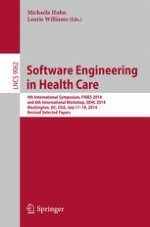2017 | Buch
Software Engineering in Health Care
4th International Symposium, FHIES 2014, and 6th International Workshop, SEHC 2014, Washington, DC, USA, July 17-18, 2014, Revised Selected Papers
herausgegeben von: Michaela Huhn, Dr. Laurie Williams
Verlag: Springer International Publishing
Buchreihe : Lecture Notes in Computer Science
